Limburger cheese has a reputation for its potent aroma, but it’s also a staple in Wisconsin’s cheese-making heritage.
One of Limburger’s biggest fans, John Jaeggi, is the coordinator for the Wisconsin Master Cheese Maker program at the Center for Dairy Research. He’s also a go-to judge for the “stinky cheese” categories at competitions.
He says there’s a historical aspect to Limburger cheese in Wisconsin because of the immigrants who came here during the 1800s from Switzerland and Germany who specialized in surface-ripened cheeses. A surface-ripened cheese means there are bacteria, yeasts, and molds that are supposed to grow on the rind for production and aging. That bacteria has a stink!
Limburger was popular in the early 1900s — Kraft Foods was heavily involved in production. Jaeggi says Limbruger started falling out of favor in the mid-1900s. That’s when cartoons and other elements of pop culture at the time used Limburger cheese as the butt of a joke, giving the cheese a stinky reputation. Also at that time, more cheese varieties started to emerge.
Jaeggi says there are a lot of cheeses out there that have a similar flavor profile to Limburger that consumers are driven toward. What people don’t know is that foods like nacho cheese (the kind you’d find over a plate of chips at the ballpark) use Limburger cheese as an ingredient.
Jaeggi enjoys it on rye bread with mustard and sweet onion. He recommends making Monroe Cheese Days a destination Sep. 20-22 for the Limburger tasting contest.


